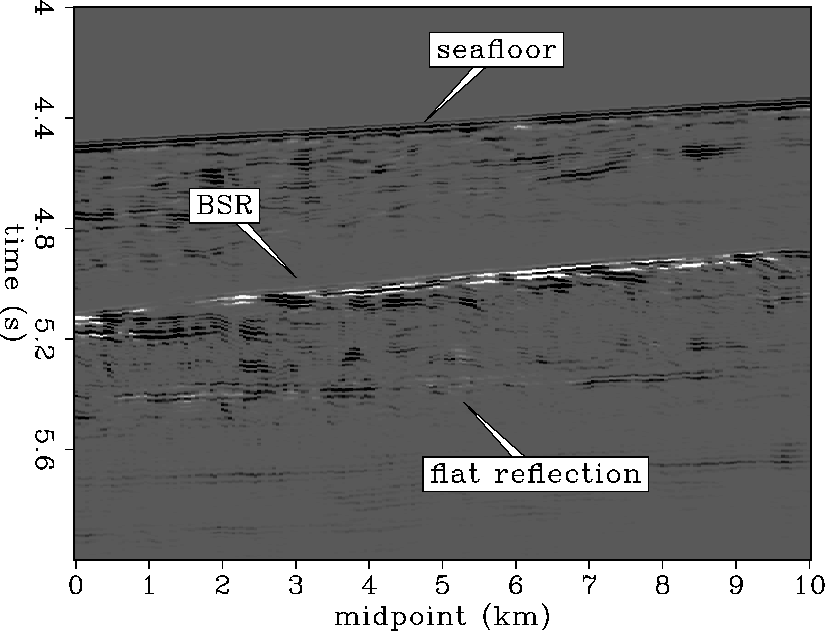![[*]](http://sepwww.stanford.edu/latex2html/cross_ref_motif.gif) . P and S impedance contrasts of the same signs
are plotted dark grey, contrasts of opposite signs are plotted white.
. P and S impedance contrasts of the same signs
are plotted dark grey, contrasts of opposite signs are plotted white.
The P impedance contrast section shows clearly that the seafloor reflection
and BSR have P impedance contrasts of opposite polarity. In a small section
right above the BSR, there is a ``quiet'' zone where no diffractions or
reflections are visible. Below the BSR a horizontal reflector gives a strong
impedance contrast of the same polarity as the seafloor. The S impedance
contrast section is dominated by a lot of diffraction signals, since the data
are unmigrated. The seafloor has a much weaker shear impedance contrast than
the BSR, but it is evident that both have the same polarity. The horizontal
reflector below the BSR nearly disappears in this section suggesting that this
transition zone has a very small S impedance contrast. A simple multiplication
of the P and S impedance contrast sections produces a P*S anomaly map shown
in Figure ![[*]](http://sepwww.stanford.edu/latex2html/cross_ref_motif.gif) . P and S impedance contrasts of the same signs
are plotted dark grey, contrasts of opposite signs are plotted white.
. P and S impedance contrasts of the same signs
are plotted dark grey, contrasts of opposite signs are plotted white.
 |
Having a calibrated amplitude AVO response, the seafloor results show an equal magnitude, positive P and S impedance contrast. The BSR has clearly opposite P and S impedance polarity. From the AVO amplitude responses it is known that the amplitudes of the BSR increase negative with increasing offset. This means that the reflector has a positive S and negative P impedance contrast. A hydrate-gas transition would explain such P and S impedances, whereas a hydrate-brine transition zone can be expected to have both negative P and S impedances. Thus, the presence of free gas below the BSR seems to be indicated. The ``quiet'' zone above the BSR where no reflections or diffractions can be seen might be explained by the presence of disseminated methane hydrate. Assuming that the BSR is associated with the base of the methane hydrate stability field, the hydrate accumulates right above the BSR and diminishes gradually with increasing height. The ice-like particles behave like small point scatterers for an incident seismic signal and mask each other. The bright reflector beneath the BSR has a positive P impedance contrast and may have a negative S impedance contrast, although the signal is quite weak. This could indicate a reflection at the bottom of the free methane gas layer overlying normal brine-saturated sediments. Such a transition zone has a positive P impedance contrast and a small, if any, positive S impedance contrast. Furthermore, a gas-water contact is likely to give a horizontal reflection as the base of gas is not following a pressure-temperature boundary but is controlled by gravity. Such horizontal reflectors are usually known as flat spots, and are often found to correlate with gas-fluid contacts.
Assuming a seafloor reflection coefficient of 0.2 and fixing the P and
S impedance contrasts of the seafloor to 0.4 each, it
is possible to estimate the relative impedance contrasts of the BSR by
determining the average amplitude changes between seafloor and BSR.
This results in a P impedance contrast of -0.4 which has the same magnitude but
opposite polarity to the seafloor. The S impedance contrast is very strong
and amounts to approximately 0.8 to 1.2 which is two to three times as much
as the seafloor impedance contrast of the same polarity. This high magnitude
has the effect of visually diminishing the S impedance contrast of the seafloor
(Figure ![[*]](http://sepwww.stanford.edu/latex2html/cross_ref_motif.gif) ) compared with the P impedance contrast (Figure
) compared with the P impedance contrast (Figure ![[*]](http://sepwww.stanford.edu/latex2html/cross_ref_motif.gif) ) which actually are scaled to be the same.
) which actually are scaled to be the same.
Given the stacked section of the processed data (Figure ![[*]](http://sepwww.stanford.edu/latex2html/cross_ref_motif.gif) ), the
geology was interpreted using the impedance inversion results
(Figure
), the
geology was interpreted using the impedance inversion results
(Figure ![[*]](http://sepwww.stanford.edu/latex2html/cross_ref_motif.gif) ).
The water bottom overlays marine sediments that gradually accumulate into
methane hydrate with depth. Since the transition is gradual, it can not be seen
as reflections in the data. The hydrate zone may be characterized by many small
ice diffractors which eliminate each other effects and create a seismic
``quiet'' zone. The bottom of the methane hydrate gives a strong reflection of negative
polarity. Based on the impedance contrasts and AVO amplitude responses, the
hydrate is assumed to overlay sediments in which free gas is trapped. The flat
reflector below the BSR could correspond to a gas-water contact, but has to be
investigated in more detail before a final interpretation can be made.
).
The water bottom overlays marine sediments that gradually accumulate into
methane hydrate with depth. Since the transition is gradual, it can not be seen
as reflections in the data. The hydrate zone may be characterized by many small
ice diffractors which eliminate each other effects and create a seismic
``quiet'' zone. The bottom of the methane hydrate gives a strong reflection of negative
polarity. Based on the impedance contrasts and AVO amplitude responses, the
hydrate is assumed to overlay sediments in which free gas is trapped. The flat
reflector below the BSR could correspond to a gas-water contact, but has to be
investigated in more detail before a final interpretation can be made.